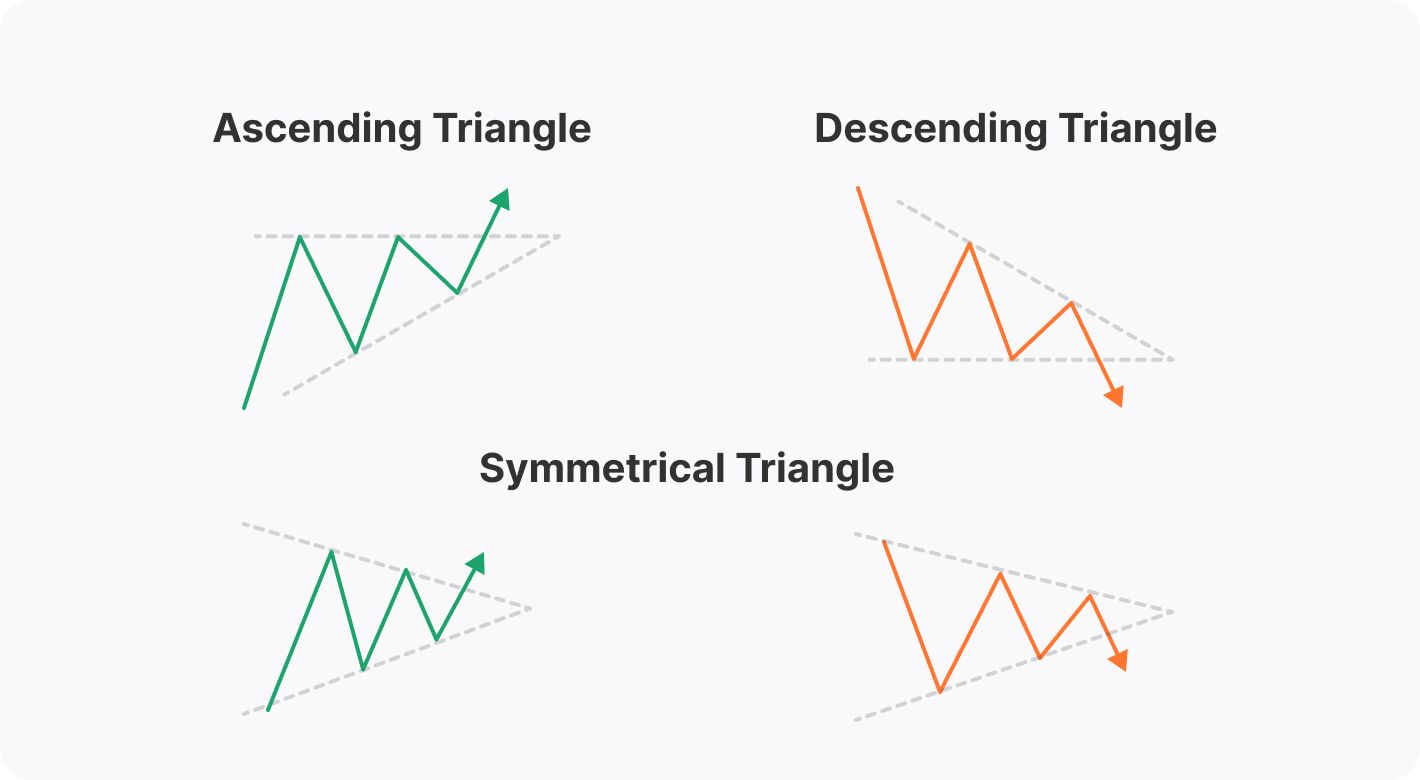FXOpen

In technical analysis, a symmetrical triangle is a tool that traders use to forecast a price direction. It’s a bilateral pattern, meaning it provides buy and sell signals. This is the biggest challenge for traders. In this FXOpen article, we will try to explain how to read the symmetrical triangle.
What Is a Symmetrical Triangle Pattern?
A symmetrical triangle, also known as a symmetrical wedge pattern, is a formation that relates to the triangle group, which also includes ascending and descending triangles. It’s a bilateral setup, so it may signal a fall or rise in the price.
Moreover, as with ascending and descending triangles, it can occur in an uptrend and downtrend and forecast either a trend reversal or continuation. Still, according to the work Technical Analysis of Stock Trends by Robert D. Edwards and John Magee, in 75% of cases, a symmetrical triangle is a continuation pattern. Therefore, it can be assumed that a bullish symmetrical triangle occurs in an uptrend, while a bearish symmetrical triangle appears in a downtrend.
The triangle consists of two sloping trendlines – the upper line connects at least two lower highs, while the lower line goes through at least two higher lows. Like ascending and descending triangles, the symmetrical formation appears in market consolidation periods.
The formation can be found on any timeframe of any asset. That is, there are symmetrical triangles on stock, commodity, cryptocurrency*, and forex markets. The symmetrical triangle forms from several minutes to several months, depending on the timeframe.
Descending, Ascending, and Symmetrical Triangles: The Differences
Ascending, descending, and symmetrical triangles comprise a group of triangle patterns. Each of them may forecast a trend continuation and reversal. The main difference is the signals they provide. The ascending triangle is a bullish pattern that forecasts only a price rise. The descending triangle is a bearish setup that signals only a price fall. The symmetrical triangle can be both bullish and bearish.
To distinguish between them, a trader needs to draw trendlines.
- In an ascending triangle, the upper line is horizontal, and the lower line is angled up, connecting higher lows.
- In a descending triangle, the upper boundary is angled down and connects lower highs, and the lower is horizontal.
- In a symmetrical triangle, the upper boundary falls while the lower rises.

How to Trade The Symmetrical Triangle
Most chart patterns have specific entry and exit rules, and the symmetrical triangle is no exception. Still, traders should remember that these rules don’t guarantee a successful trade. Therefore, many traders modify them to suit their trading approaches. You can use the TickTrader platform to develop your own rules for triangle trading.
The rules below suit long and short trades.
Entry
The idea of any triangle is to enter the market on a breakout. As the symmetrical triangle provides buy and sell signals, a trader waits for a symmetrical triangle breakout of either trendline. Let’s remember that, more often, this setup forecasts a trend continuation. Therefore, it’s more likely the upper boundary will be broken in an uptrend and a lower boundary will be broken in a downtrend.
Traders may open a position as soon as the breakout candlestick closes or wait for several candles to be formed in the breakout direction. The choice depends on a trader’s experience and willingness to take risks.
One of the symmetrical triangle disadvantages is a risk of a false breakout when the price returns to the pattern. Therefore, traders use various tools to confirm price moves.
The first signal of the strong breakout is increased trading volumes. If the price moves beyond the trendline and the volumes rise, the risk of a fakeout is lower. Also, as the symmetrical triangle may provide both buy and sell signals, traders widely use trend reversal indicators such as the relative strength index, the moving average convergence divergence, and the stochastic oscillator. If a price reversal isn't confirmed, there is a lower chance of a fakeout.
Take Profit
The common rule is to measure the widest part of the setup and calculate the same distance from the breakout trendline.
Stop Loss
No matter what indicator or pattern traders use, many rely on the standard risk/reward ratio of 1:2 and 1:3, which can be increased if a trader doesn't feel confident.
Another trader’s method is to place the stop-loss order just under the upper trendline in a buy trade and above the lower one in a downtrend.
Triangle Trading: Example

A pattern formed on the 4-hour chart of the GBP/USD pair. As it was a solid uptrend, a trader could expect it to continue. If they opened a buy position as soon as the breakout candlestick closed, the setup standard rules would work. However, if they waited for several candles to form in the breakout direction, the price wouldn't reach the target, and the position would be closed by a stop-loss order.
A take-profit level would equal the size of the triangle’s widest part (1) and would be set just from the upper trendline. A stop-loss order could be calculated according to the risk-reward ratio of 1:2 and placed at point 2.
Symmetrical Triangle: Benefits and Drawbacks
The primary challenge of the symmetrical triangle setup is its confusing signals. However, this is not the only aspect you should consider when entering the market.
Benefits
- It occurs in any timeframe. Triangles earned recognition due to their ability to be formed in every timeframe. However, if the trend is solid, the triangle's signals may be more reliable.
- It is used when trading various assets. Traders look for the symmetrical triangle on stocks, commodities, cryptocurrencies*, indices, and currencies price charts.
- It can be easily identified. A trader only needs to draw two lines to determine a symmetrical triangle on a chart. You can practise on the TickTrader platform.
- It offers exact entry and exit points. Triangles offer particular entry and exit points, which can be used directly or with little corrections according to a trader's approach.
Drawbacks
- It may be confusing. Is the symmetrical triangle bullish or bearish? Unlike ascending and descending setups, the symmetrical triangle could be either.
- Fakeouts. There is a significant risk of a false breakout, as triangles are consolidation formations, reflecting market uncertainties.
- It may fail. As with other patterns, there is no guarantee the price will behave according to a triangle's signals.
- The trading rules may fail. The effectiveness of standard entry and exit rules depends on market conditions.
Does the Symmetrical Triangle Work?
The effectiveness of the symmetrical triangle depends on market conditions and trader skills. Before implementing the symmetrical triangle in forex trading, or any other market, traders learn its unique features, test it in real market conditions, and adjust its rules to their trading approaches. You can open an FXOpen account to test various strategies with the triangle pattern.
*At FXOpen UK, Cryptocurrency CFDs are only available for trading by those clients categorised as Professional clients under FCA Rules. They are not available for trading by Retail clients.
This article represents the opinion of the Companies operating under the FXOpen brand only. It is not to be construed as an offer, solicitation, or recommendation with respect to products and services provided by the Companies operating under the FXOpen brand, nor is it to be considered financial advice.
Stay ahead of the market!
Subscribe now to our mailing list and receive the latest market news and insights delivered directly to your inbox.








